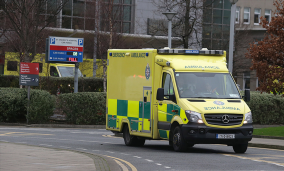'Absolutely shocking' – ambulances fail to meet target times amid lack of A&E capacity

Almost two-thirds of ambulances bringing patients to hospital are being held up for more than half an hour, preventing them from responding to potentially life-threatening emergencies.
New figures show the HSE’s turnaround target of 30 minutes for 95pc of ambulances to deliver a patient to hospital and be back in service was met in only 37.1pc of cases in September.
The target of 20 minutes for 95pc of ambulances, set by the watchdog Hiqa, was managed by only 15.9pc of ambulances.
The worrying figures, obtained by Fianna Fáil health spokesperson Stephen Donnelly, mark a deterioration in ambulance turnaround performance.
Please log in or register with Independent.ie for free access to this article.
Log In
New to Independent.ie? Create an account
Mr Donnelly said ambulance turnaround times measured the interval from an ambulance’s arrival at a hospital to when the crew was ready to accept another call.
“These figures are absolutely shocking but what makes it worse is the fact that two years ago in September 2017 these figures stood at 25.2pc and 53.2pc for the 20-minute and 30-minute targets,” he said.
“Locally, some of the figures are truly astounding. In Kerry, just 1.7pc of ambulances managed the 20-minute turnaround.”
Meanwhile, another five hospitals nationwide failed to achieve the 5pc level.
“The decline in the transfer turnaround times is yet another reflection of the pressures on hospitals and the lack of capacity to cope,” said Mr Donnelly.
“The main reason for the delay is because emergency departments are too busy with too few staff to process a patient coming in by ambulance.
“It’s another vicious cycle; if emergency departments are overcrowded, it causes delays in taking patients from ambulances.
“If there is a delay taking patients in from ambulances, then the ambulance response times are going to worsen.
“If ambulance response times worsen, then people in emergencies and in urgent need of an ambulance are going to find themselves in a very dangerous situation,” he warned.
The HSE has received €26m in a bid to ease the trolley crisis this winter by moving more patients out of hospital to more appropriate step-down care, including nursing homes and home care.
However, as the spread of flu increases and vulnerable patients, particularly the elderly, face complications this winter, the pressure on A&E units throughout the country is set to mount.
HSE chief operations officer Anne O’Connor said acute hospitals were continuing to see a year-on-year increase in the number of patients requiring treatment and care.
By the end of October, 1.1 million patients had attended the 29 emergency departments, 3pc more than at the same time last year.
“Almost 292,000 were patients admitted to hospital for further treatment and care. The average weekly number of patients waiting in hospitals for a transfer of care is 674, a 20pc increase compared to last year.
“This significantly impacts hospitals’ capacity to admit new patients and therefore waiting times in emergency departments have been longer than we would wish,” she said.
Source: Read Full Article